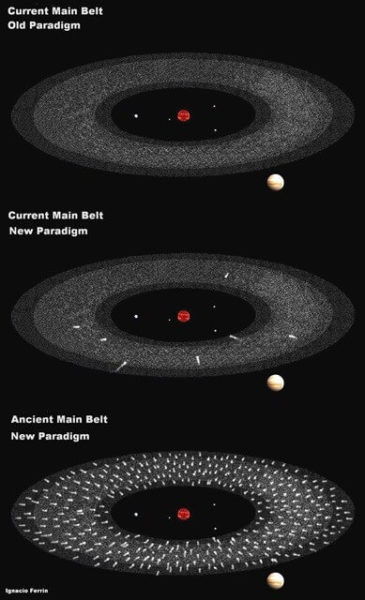A team of astronomers from the University of Anitoquia, Medellin, Colombia, have discovered a graveyard of comets. The researchers, led by Anitoquia astronomer Prof. Ignacio Ferrin, describe how some of these objects, inactive for millions of years, have returned to life leading them to name the group the ‘Lazarus comets’. The team publish their results in the Oxford University Press journal Monthly Notices of the Royal Astronomical Society.
Comets are amongst the smallest objects in the Solar System, typically a few km across and composed of a mixture of rock and ices. If they come close to the Sun, then some of the ices turn to gas, before being swept back by the light of the Sun and the solar wind to form a characteristic tail of gas and dust.
Most observed comets have highly elliptical orbits, meaning that they only rarely approach the Sun. Some of these so-called long period comets take thousands of years to complete each orbit around our nearest star. There is also a population of about 500 short period comets, created when long period comets pass near Jupiter and are deflected in orbits that last anything between 3 and 200 years. Although uncommon events, comets also collide with the Earth from time to time and may have helped bring water to our planet.
The new work looked at a third and distinct region of the Solar System, the main belt of asteroids between the orbits of Mars and Jupiter. This volume of space contains more than 1 million objects ranging in size from 1 m to 800 km. The traditional explanation for asteroids is that they are the building blocks of a planet that never formed, as the movement of the pieces was disrupted by the strong gravitational field of Jupiter.
In the last decade 12 active comets have been discovered in the asteroid main belt region. This was something of a surprise and the Medellin team set out to investigate their origin. The team, made up of Prof. Ferrin and his colleagues Profs. Jorge Zuluaga and Pablo Cuartas, now think they have an explanation.
“We found a graveyard of comets”, exclaims Professor Ferrín. He adds: “Imagine all these asteroids going around the Sun for aeons, with no hint of activity. We have found that some of these are not dead rocks after all, but are dormant comets that may yet come back to life if the energy that they receive from the Sun increases by a few per cent.”
Surprisingly, this can happy fairly easily, as the orbits of many objects in the asteroid belt are nudged by the gravity of Jupiter. The shape of their orbits can then change, leading to a decrease in the minimum distance between the object and the Sun (perihelion) and a slight increase in average temperature.
According to this interpretation, millions of years ago the main belt was populated by thousands of active comets. This population aged and the activity subsided. What we see today is the residual activity of that glorious past. Twelve of those rocks are true comets that were rejuvenated after their minimum distance from the Sun was reduced a little. The little extra energy they received from the Sun was then sufficient to revive them from the graveyard.
Prof. Ferrin describes the 12 active comets. “These objects are the ‘Lazarus comets’, returning to life after being dormant for thousands or even millions of years. Potentially any one of the many thousands of their quiet neighbours could do the same thing.”
Further information
The new work can be seen in:
“The location of Asteroidal Belt Comets (ABCs) in a comets’ evolutionary diagram: The Lazarus Comets”, Ignacio Ferrín, Jorge Zuluaga, Pablo Cuartas, Monthly Notices of the Royal Astronomical Society, in press. The paper is available at http://mnras.oxfordjournals.org/content/early/2013/07/30/mnras.stt839.full and a preprint can be seen at http://arxiv.org/ftp/arxiv/papers/1305/1305.2621.pdf


